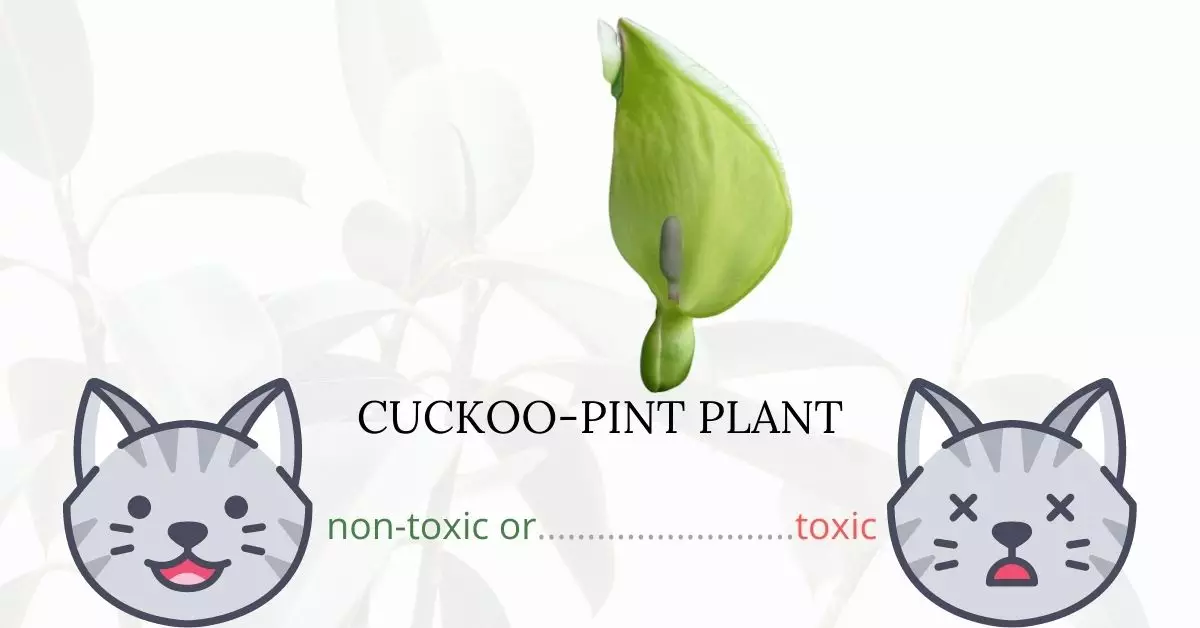Yes, the Cuckoo-pint plant is indeed toxic to cats, posing significant health risks if ingested.
This article is formulated in collaboration with a team of experienced DVMs (Doctors of Veterinary Medicine) who lend their expertise to elucidate the potential risks associated with various plants, such as the Cuckoo-Pint Plant, and their effects on cats. Through their valuable contributions, we can deliver accurate and contemporary information to pet owners and enthusiasts. Moreover, we have corroborated our findings by researching high-authority websites such as ASPCA and PetMD to ensure the reliability of every piece of information provided on each plant.
Cuckoo-pint, belonging to the Araceae family, is a woodland plant notorious for containing insoluble calcium oxalates. When ingested, these compounds induce a severe burning sensation in the mouth, throat, lips, and tongue and can cause excessive drooling, gagging, choking, and potentially serious swelling of the throat, making swallowing extremely difficult. It is critical to note that all parts of the cuckoo-pint plant are toxic, with the majority of calcium oxalates being concentrated in its bright-colored berries.
Clinical Signs of Cuckoo-Pint Poisoning in Cats
When cats come into contact with or ingest the Cuckoo-pint plant, several clinical signs may manifest due to the toxic components present in the plant. Each symptom arises from the body’s reaction to the toxic principles, primarily insoluble calcium oxalates.
- Oral Irritation: Upon chewing or biting the plant, the immediate release of calcium oxalates can cause a sharp and intense burning sensation in the cat’s mouth. These needle-shaped crystals can puncture the tissue, leading to pain and irritation.
- Excessive Drooling: This is a direct result of the oral irritation. Cats drool as a mechanism to rid the mouth of the irritating substance and alleviate the burning sensation.
- Choking and Swelling of the Throat: The plant’s compounds can cause inflammation and swelling in the throat, which can interfere with normal breathing and swallowing.
- Gagging: As a result of the oral and throat irritation, a cat might gag in an attempt to expel the plant material or to cope with the discomfort.
- Inability or Difficulty Swallowing: The swelling and inflammation in the throat can hinder the cat’s ability to swallow properly, leading to this symptom.
- Gastrointestinal Distress: If ingested, the plant can irritate the gastrointestinal tract, leading to symptoms like vomiting and diarrhea.
When larger quantities of the Cuckoo-pint plant are consumed, more severe clinical signs may arise:
- Severe Digestive Upset: Beyond just gastrointestinal distress, a cat may experience intense abdominal pain, vomiting, and diarrhea.
- Extreme Difficulty Breathing: Swelling of the throat, combined with inflammation, can obstruct the airways, making it challenging for the cat to breathe.
- Shallow, Rapid Breaths or Dyspnea: Resulting from the aforementioned breathing difficulties, the cat may take rapid, shallow breaths in an attempt to get more oxygen.
- Convulsions: The toxic effects can impact the nervous system, causing seizures or convulsions in more severe cases.
- Renal Failure: Calcium oxalates can have a detrimental effect on the kidneys, potentially leading to renal failure if not treated promptly.
- Coma: In extreme cases, the cumulative toxic effects can overwhelm the cat’s system, leading to a coma.
- Death: In the most severe instances, if not treated in a timely manner, the toxic effects of the Cuckoo-pint plant can unfortunately lead to death.
It’s essential to act quickly if you suspect your cat has been exposed to the Cuckoo-pint plant. Immediate veterinary attention can make all the difference in the outcome.
First Aid and Treatment of Cuckoo-Pint Poisoning in Cats
Intravenous fluid therapy will be given if your cat is dehydrated due to vomiting and diarrhea. If breathing problems arise as a result of throat swelling, oxygen therapy will be started. An antihistamine may be used to ease the inflammation and irritation that the oxalate crystals caused. If your cat is unable to take the medication orally, it will be injected straight into his or her body.
Other medications such as Kapectolin and sucralfate may be also administered by the vet to your cat. These medications are used to prevent calcium oxalates from further embedding in your cat’s mouth, throat, stomach, and intestine. The coating activity of Kapectolin protects the stomach lining while sucralfate, which combines with stomach acids to generate a paste-like material that functions as a barrier between the stomach and its contents, can also be used to treat gastrointestinal irritation.
Recovery from Cuckoo-Pint Poisoning in Cats
In most cases of cuckoo-pint poisoning, the cat will make a full recovery within 12 to 24 hours. Although severe calcium oxalate poisoning can be treated, in most cases irreparable liver and kidney damage has already occurred. After treatment, talk to your veterinarian to discuss the supportive care needed by your cat at home.
Prevention of Cuckoo-Pint Poisoning in Cats
Remove cuckoo-pint plants from your yards, if they are growing here. If cuckoo-pints are growing around your area, you should limit your cat’s access outdoors to lessen the risk of exposure to cuckoo-pint and other toxic plants.
If you love plants but have cats at home, check out these lists:





